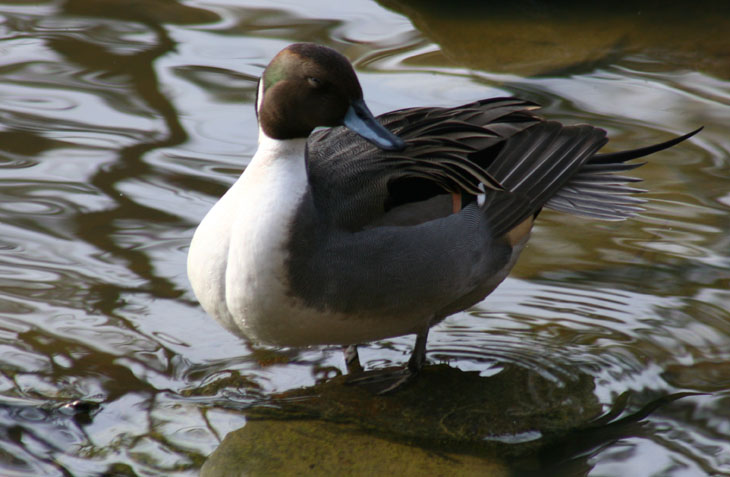
Despite the weather and the holidays, I do still get out to do some shooting now and then, even though the pics in this post were from… jeez… ten days ago. These were taken, with one exception, at a botanical garden during a halfway-decent day. Above, a pintail duck (Anas acuta) provides a dozing pose as the cloud cover thickened up.
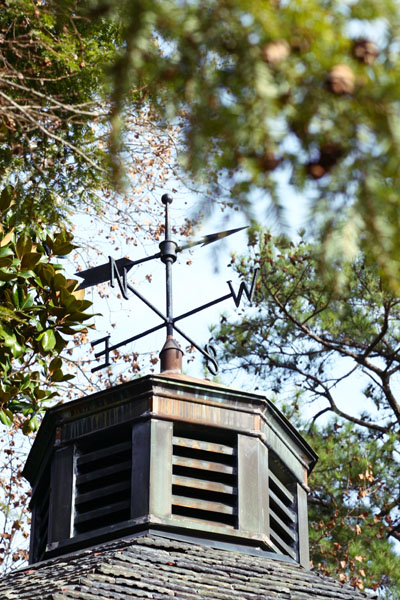 While UNC’s Botanical Gardens are dedicated mostly to native NC plants and replicating natural habitats, this one was more decorative and landscaped. It’s all a matter of taste; I prefer the natural-looking stuff more, and actually hate most of what passes for landscaping anymore, especially the lone decorative tree in a mound of pinestraw mulch – I have no idea how that became the standard in the US, but it’s unbelievably pathetic, like using a kindergarten drawing as a decorative plan. Lest I give the wrong impression, this one was quite a bit better than that, with a pleasant layout and some real effort put into aesthetics, but it still says “artificial” too much for me. It is a favored locale for weddings and bridal shoots, but they charge a ridiculous fee just for a portrait permit, and because of this I have removed all references to them from my posts – sorry, no free advertising on this end.
While UNC’s Botanical Gardens are dedicated mostly to native NC plants and replicating natural habitats, this one was more decorative and landscaped. It’s all a matter of taste; I prefer the natural-looking stuff more, and actually hate most of what passes for landscaping anymore, especially the lone decorative tree in a mound of pinestraw mulch – I have no idea how that became the standard in the US, but it’s unbelievably pathetic, like using a kindergarten drawing as a decorative plan. Lest I give the wrong impression, this one was quite a bit better than that, with a pleasant layout and some real effort put into aesthetics, but it still says “artificial” too much for me. It is a favored locale for weddings and bridal shoots, but they charge a ridiculous fee just for a portrait permit, and because of this I have removed all references to them from my posts – sorry, no free advertising on this end.
This time of year, unsurprisingly, is not the best for foliage of any kind, nor arthropods, so much of my efforts went towards trying to find some kind of fartistic abstract compositions – I’ll leave it to you as to whether I succeeded or not, since that’s how art works anyway, but will say that I didn’t come home with much that bowled me over, though there are still a few that I liked. No small portion of my time went towards chasing the waterfowl that reside in the large pond, and we’ll see more of them anon.
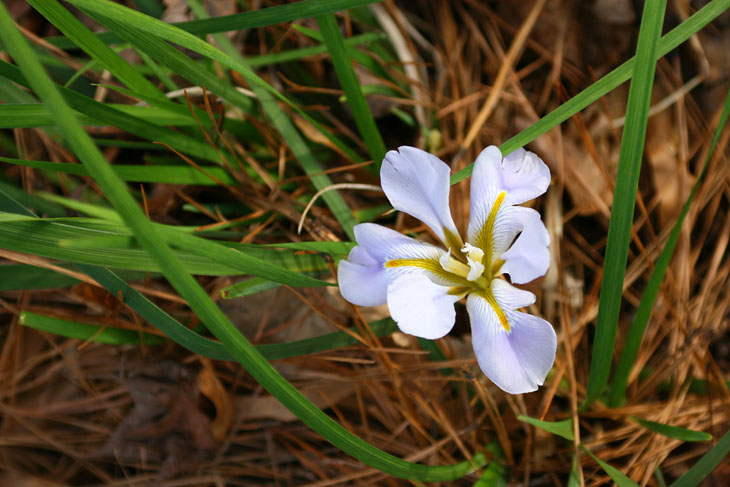
I’m just going to hazard that this is some kind of lily, and leave it at that – I tried looking it up, but there is such a huge variety of them that I wasn’t finding this exact species. This one was sitting, all alone and forlorn, at the edge of a trail, and the light was right for delicate colors and shapes of this nature. It’s best not to try and shoot flowers in bright sunlight, since the contrast makes it difficult to get the curves of the petals and the variations of color to come out well.
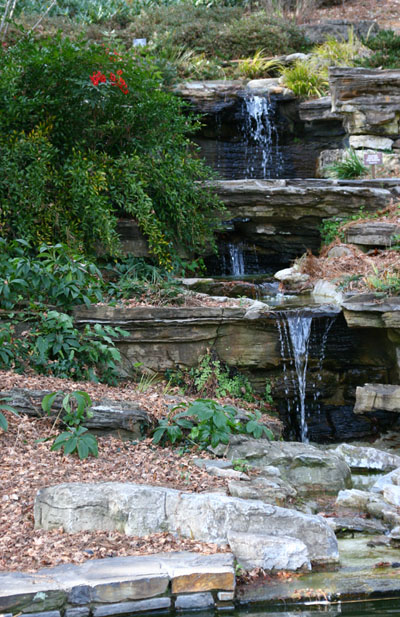 We’re not talking high art here, but I just wanted to point out something curious. The red in this image takes up a tiny percentage of the total area, but because it forms such a marked contrast from both its immediate surroundings and from the tones of the entire frame, it grabs attention – we notice it, but there’s no reason to look at it closely because it’s immediately apparent what it is. Since it’s there, however, it has to take a balanced place in the framing; too close to the edge, and it would seem cut off and perhaps subconsciously uncomfortable to the viewer, while putting it closer to the center implies there’s more that we should be paying attention to, without good reason. Yet without that dribble of red, the image would appear (even more) lacking in color, heavy emphasis on the grey-blue cast of overcast days – it was actually in deep shade during bright but hazy conditions, the same conditions as the weathervane pic above. It illustrates the difference between a dominant shape or subject within the frame, and a dominant contrast element, which can be quite small and still effective. It also demonstrates how small a distracting element could be – say, if this was a car in the background, or a person in a bright jacket. It is important for a photographer to see these things, not as discrete ideas like “waterfall” and “berries,” but as elements of color and contrast that will draw the eye, for good or for bad.
We’re not talking high art here, but I just wanted to point out something curious. The red in this image takes up a tiny percentage of the total area, but because it forms such a marked contrast from both its immediate surroundings and from the tones of the entire frame, it grabs attention – we notice it, but there’s no reason to look at it closely because it’s immediately apparent what it is. Since it’s there, however, it has to take a balanced place in the framing; too close to the edge, and it would seem cut off and perhaps subconsciously uncomfortable to the viewer, while putting it closer to the center implies there’s more that we should be paying attention to, without good reason. Yet without that dribble of red, the image would appear (even more) lacking in color, heavy emphasis on the grey-blue cast of overcast days – it was actually in deep shade during bright but hazy conditions, the same conditions as the weathervane pic above. It illustrates the difference between a dominant shape or subject within the frame, and a dominant contrast element, which can be quite small and still effective. It also demonstrates how small a distracting element could be – say, if this was a car in the background, or a person in a bright jacket. It is important for a photographer to see these things, not as discrete ideas like “waterfall” and “berries,” but as elements of color and contrast that will draw the eye, for good or for bad.
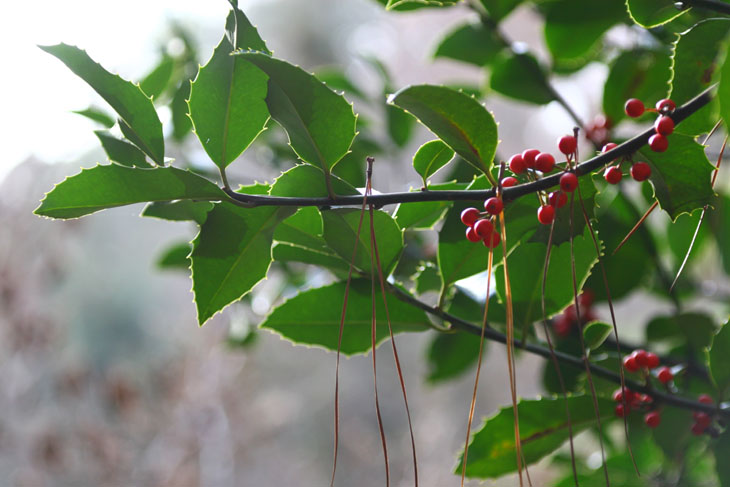
This is just an illustration of one of my frustrations, a frustillustration if you will. Longneedle pines are not only ugly trees, their needles fall constantly, all year long, and get all over everything – I very frequently pick them out of compositions. These little bastards even fall with enough force to pierce through leaves of other plants, such as The Girlfriend’s Younger Sprog’s shamrocks. Very annoying.
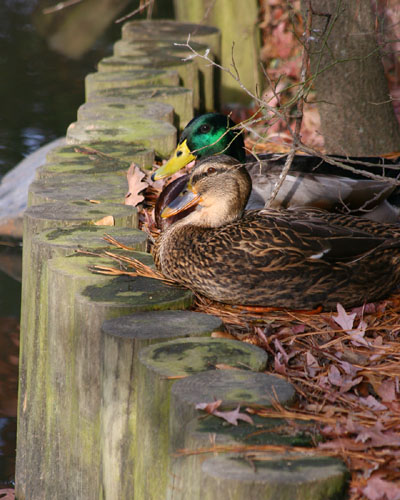 On to the ducks. Yeah, I know, mallards (Anas platyrhynchos) are probably the most common duck in North America, so no remarkable skills here, but I liked the composition with the lighting, and this does show the sexual dimorphism that is common in bird species and very pronounced in many ducks – the female is in front, the male behind. The males typically have the bright, elaborate plumage to attract the attention of the females, who perform the selection of mates. The plumage is an indication of health, as well as simply standing out – even we, a completely unrelated species, can spot an unhealthy bird from a short distance. More interesting is how the colors work, since they only appear this bright in direct sunlight, having a certain refractive quality to the feathers (also note the pintail at the top of the post.) In diffuse light to shade, however, the colors almost vanish, becoming so muted they only garner a tiny percentage of the attention, allowing the birds to roost in the shade safely without sending out much of a signal to predators. As is hinted at in the image, this pair were nestled in under a tree, and only the angle of the late afternoon sun threw this bright light upon them; the same conditions (in almost the exact same location) can be seen in this wood duck photo.
On to the ducks. Yeah, I know, mallards (Anas platyrhynchos) are probably the most common duck in North America, so no remarkable skills here, but I liked the composition with the lighting, and this does show the sexual dimorphism that is common in bird species and very pronounced in many ducks – the female is in front, the male behind. The males typically have the bright, elaborate plumage to attract the attention of the females, who perform the selection of mates. The plumage is an indication of health, as well as simply standing out – even we, a completely unrelated species, can spot an unhealthy bird from a short distance. More interesting is how the colors work, since they only appear this bright in direct sunlight, having a certain refractive quality to the feathers (also note the pintail at the top of the post.) In diffuse light to shade, however, the colors almost vanish, becoming so muted they only garner a tiny percentage of the attention, allowing the birds to roost in the shade safely without sending out much of a signal to predators. As is hinted at in the image, this pair were nestled in under a tree, and only the angle of the late afternoon sun threw this bright light upon them; the same conditions (in almost the exact same location) can be seen in this wood duck photo.
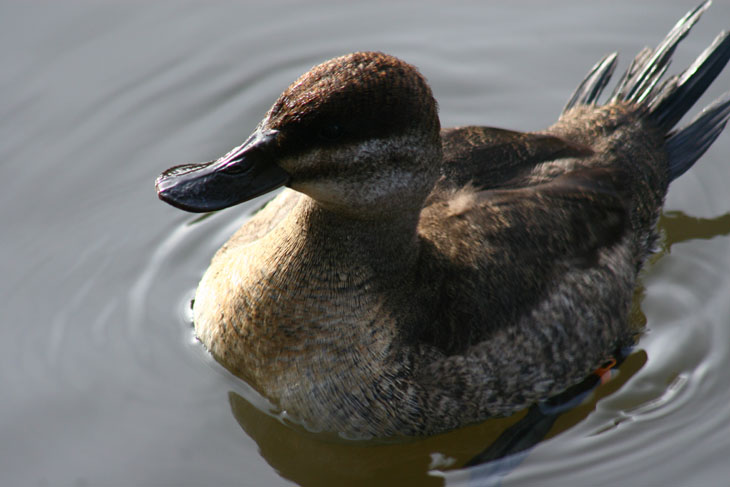
I don’t know what kind of duck this is, since my guide didn’t seem to have any match, and since there are a couple of known exotic, introduced species that hang out at that pond, my suspicion is this is another. It’s about half the size of the mallards, and at least one pair was visible, so I’m fairly certain this is the male – quite a contrast from the coloration of the mallards, and ridiculously far from either wood ducks or the mandarins that were also present, which did not hold still well enough in decent light for me to get an acceptable image of, so seeing them will wait for another opportunity – I’d like to get the wood ducks during nesting season anyway, so keep watching in the spring. But I liked these little guys anyway.
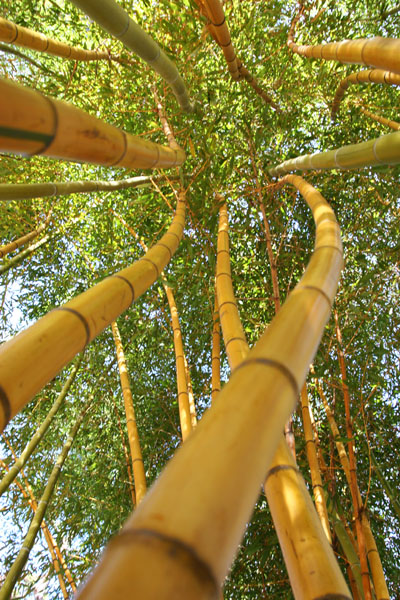 Just an experiment in the bamboo grove, using a 19mm focal length, f8 with focus about 2 meters, and setting the camera on the ground aiming up, so taken blind. Out of several attempts, I like this composition best. Moreover, it shows no visible evidence of the graffiti that adorns most of the stalks, because the garden is frequented by college students who, on the whole, have not grown the fuck up yet. There’s not much you can do to bamboo when trying to carve your initials into the trunks, except produce a weak discoloration, but this is apparently enough for those who are desperate to leave their mark but lacking in any talent whatsoever – not everyone can be a pop star (really got the Old Man Thing going today, haven’t I?) I think next time I’ll go with at least f16 and a shorter focus, since it would be better to have the bottoms of the stalks in focus; the tops going out of focus would likely enhance the height aspect. Should’ve experimented more.
Just an experiment in the bamboo grove, using a 19mm focal length, f8 with focus about 2 meters, and setting the camera on the ground aiming up, so taken blind. Out of several attempts, I like this composition best. Moreover, it shows no visible evidence of the graffiti that adorns most of the stalks, because the garden is frequented by college students who, on the whole, have not grown the fuck up yet. There’s not much you can do to bamboo when trying to carve your initials into the trunks, except produce a weak discoloration, but this is apparently enough for those who are desperate to leave their mark but lacking in any talent whatsoever – not everyone can be a pop star (really got the Old Man Thing going today, haven’t I?) I think next time I’ll go with at least f16 and a shorter focus, since it would be better to have the bottoms of the stalks in focus; the tops going out of focus would likely enhance the height aspect. Should’ve experimented more.
Speaking of experiments…

I originally shot the entire head of this plant where it sat in a decorative planter, but decided I liked the tight abstract better, so this is a much smaller portion of the frame. I’m calling this ‘kale’ because that’s what it looks like to me, but that’s not my Final Answer…
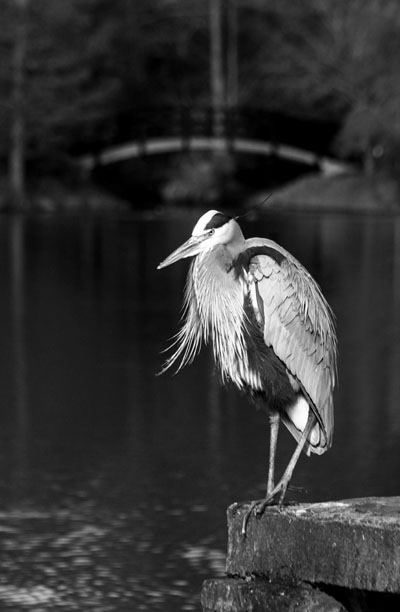 There is a resident great blue heron (Ardea herodias) at the gardens, quite possibly the same one I’ve photographed numerous times before, and it is remarkably mellow around the visitors. Great blues are variable species in this regard, since in most areas you’re likely to have a very hard time getting within fifty meters or so, but if they’ve become accustomed to human presence (usually through the prospect of easy food,) they might allow very close approaches. This image doesn’t present scale too well – they can stand well over a meter in height when fully erect, with a wingspan over two meters, and that beak is close to the length of your hand. Given the light conditions, I had to convert this one to greyscale, but did so with a technique I’ve posted about earlier, that of channel clipping. In this case, I removed the red and blue channels of the image, leaving only the green, then converted that to greyscale and increased contrast a little. The bridge in the background, which I had purposefully positioned myself to place there in the frame (since the heron, cooperative as it was, wasn’t taking instructions,) is actually bright red, but this went nearly black in the green channel. Had I used the red channel instead, the bridge would have become almost white and the foliage darker; I liked this one better. The blue channel is worthless more times than not for channel clipping, at least with the cameras I’ve used, but it does depend on what the image is of.
There is a resident great blue heron (Ardea herodias) at the gardens, quite possibly the same one I’ve photographed numerous times before, and it is remarkably mellow around the visitors. Great blues are variable species in this regard, since in most areas you’re likely to have a very hard time getting within fifty meters or so, but if they’ve become accustomed to human presence (usually through the prospect of easy food,) they might allow very close approaches. This image doesn’t present scale too well – they can stand well over a meter in height when fully erect, with a wingspan over two meters, and that beak is close to the length of your hand. Given the light conditions, I had to convert this one to greyscale, but did so with a technique I’ve posted about earlier, that of channel clipping. In this case, I removed the red and blue channels of the image, leaving only the green, then converted that to greyscale and increased contrast a little. The bridge in the background, which I had purposefully positioned myself to place there in the frame (since the heron, cooperative as it was, wasn’t taking instructions,) is actually bright red, but this went nearly black in the green channel. Had I used the red channel instead, the bridge would have become almost white and the foliage darker; I liked this one better. The blue channel is worthless more times than not for channel clipping, at least with the cameras I’ve used, but it does depend on what the image is of.
By the way, speaking of that sexual dimorphism, great blue herons are very hard to distinguish sexually, in contrast to ducks – I think this is a male, but again, Final Answer, no…
And just in case you were missing the spider images,
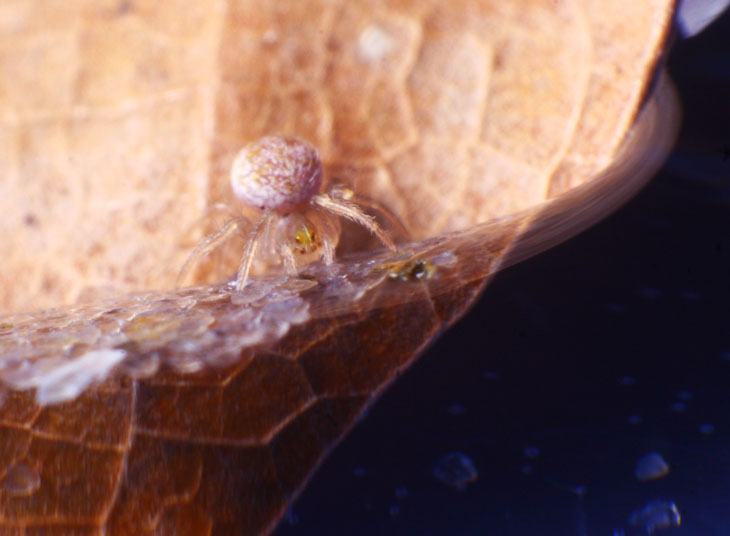
This eentsy fellow was found in the bathroom, and it’s difficult to give an impression of just how small it was, but I’ll try. What you’re seeing is a leaf in the water, and the curve across the bottom of the frame is the water lapping over onto the leaf, shaped that way by surface tension, the same thing that makes water bead up. Suspended in the water are grains of sand small enough to float. I cannot be sure of course, but I suspect the spider (an unknown species of cobweb spider) is getting a drink. I was able to compare this one against the carcass of a common fruit fly, and it measures about a third of the body length of the fly. Which begs the question of what, exactly, it feeds upon – my guess would be ghosts…
Anyway, it remains the slow season, though the days are at least getting longer again. There are still a couple of trips in the planning stages, so we’ll see what pops up in the coming month or so.




















































